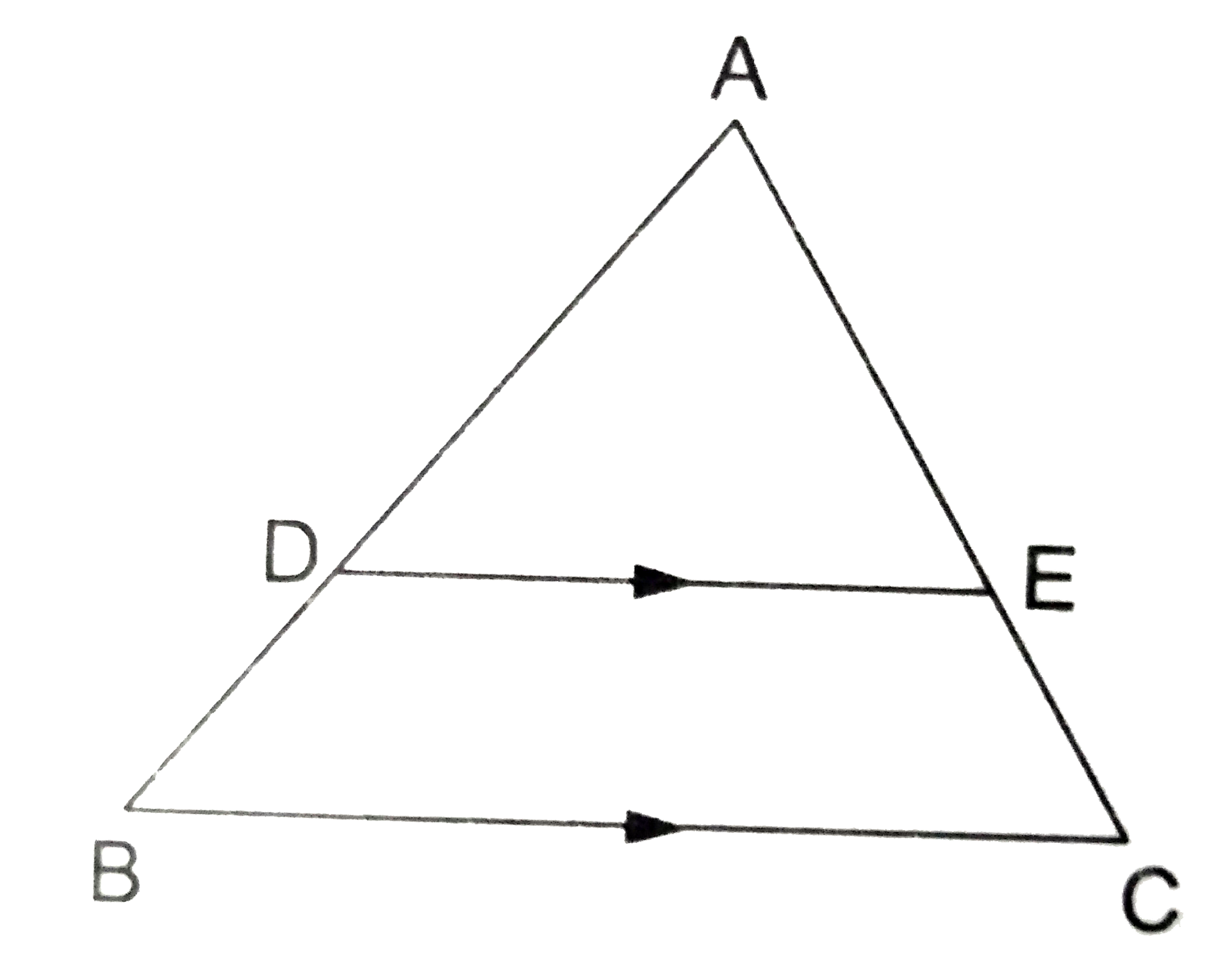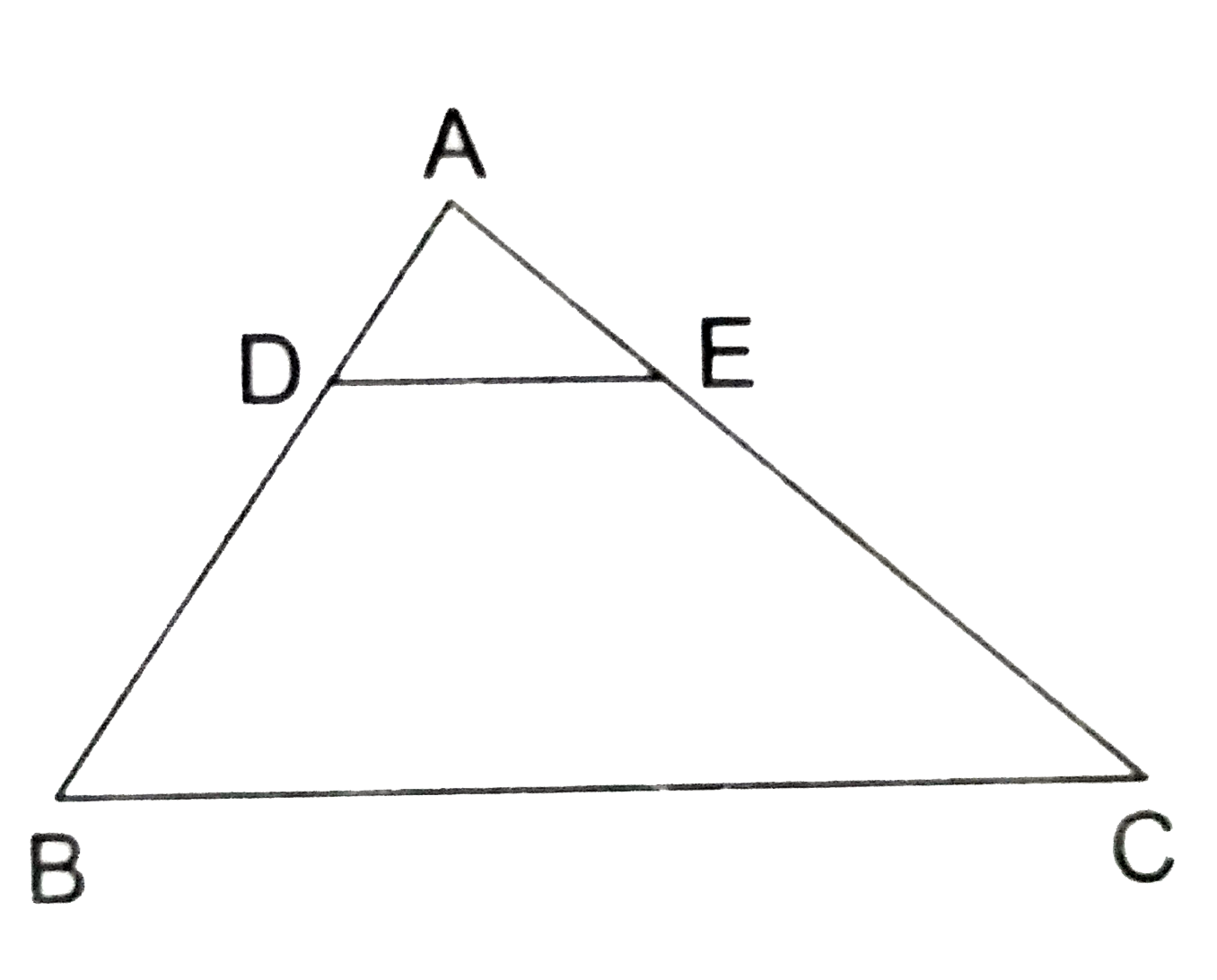If D and E are points on the sides AB and AC respectively of a triangle ABC such that DE || BC. If AD =x cm, DB =(x-3) cm, AE = ( x+ 3 ) cm and EC = ( x -2) cm, what is the value (in cm. ) of x ?
3
3.5
4
4.5
The correct Answer is:4
To solve the problem step by step, we will use the properties of similar triangles and the Basic Proportionality Theorem (BPT), which states that if a line is drawn parallel to one side of a triangle, it divides the other two sides in the same ratio.
Step 1: Set up the proportions using BPT
Since DE is parallel to BC, we can set up the following proportion based on the segments created on sides AB and AC:
ADDB=AEEC
Step 2: Substitute the given lengths into the proportion
We know:
- AD=x
- DB=x−3
- AE=x+3
- EC=x−2
Substituting these values into the proportion gives us:
xx−3=x+3x−2
Step 3: Cross-multiply to eliminate the fractions
Cross-multiplying gives us:
x⋅(x−2)=(x−3)⋅(x+3)
Step 4: Expand both sides
Expanding both sides:
- Left side: x2−2x
- Right side: Using the difference of squares formula, we have (x−3)(x+3)=x2−9
So, we can write:
x2−2x=x2−9
Step 5: Simplify the equation
Subtract x2 from both sides:
−2x=−9
Step 6: Solve for x
Dividing both sides by -1 gives:
2x=9
Now, divide by 2:
x=92=4.5
Conclusion
The value of x is 4.5 cm.
---
Since DE is parallel to BC, we can set up the following proportion based on the segments created on sides AB and AC:
ADDB=AEEC
We know:
- AD=x
- DB=x−3
- AE=x+3
- EC=x−2
xx−3=x+3x−2
Cross-multiplying gives us:
x⋅(x−2)=(x−3)⋅(x+3)
Expanding both sides:
- Left side: x2−2x
- Right side: Using the difference of squares formula, we have (x−3)(x+3)=x2−9
x2−2x=x2−9
Subtract x2 from both sides:
−2x=−9
Dividing both sides by -1 gives:
2x=9
Now, divide by 2:
x=92=4.5
The value of x is 4.5 cm.
Similar Questions
D and E are points on the sides AB and AC respectively of a ΔABC such that DE∣∣BC.
Find the value of x, when
(i) AD=xcm,DB=(x−2)cm,
AE=(x+2)cmandEC=(x−1)cm.
(ii) AD=4cm,DB=(x−4)cm,AE=8cm
and EC=(3x−19)cm.
(iii)AD=(7x−4)cm,AE=(5x−2)cm,DB(3x+4)cmandEC=3xcm.

View SolutionIf D and E are points on the sides AB and AC respectively of DetlaABC such that AB=5.6cm,AD=1.4cm,AC=7.2cmandAE=1.8cm. Show that DE∣∣BC.

View Solution
Knowledge Check
If D and E are points on the sides AB and AC respectively of a triangle ABC such that DE || BC. If AD =x cm, DB =(x-3) cm, AE = ( x+ 3 ) cm and EC = ( x -2) cm, what is the value (in cm. ) of x ?
A3B3.5C4D4.5
Let D, E be the points on sides AB and AC respectively of a triangle ABC such that DE is parallel to BC. Let AD = 2 cm, DB = 1 cm, AE = 3 cm and area of triangle ADE = 3 cm2 What is EC equal to ?
View SolutionIn △ABC, D and E are points on the sides AB and AC, respectively, such that DE || BC. If AD = 5cm, DB = 9cm AE =4cm and BC = 15.4cm, then the sum of the length of DE and EC (in cm) is:
△ABC में, D और E क्रमशः AB और AC भुजाओं पर बिंदु इस प्रकार है की DE||BC, यदि AD = 5cm, DB = 9cm AE = 4cm और BC = 15.4cm है, तो DE और EC (सेमी में) की लंबाई का योग है
View SolutionD and E are the points on the sides AB and AC respectively of a ABC such that: AD=8cm, DB=12cm, AE=6cm and CE=9cm . Prove that BC=5/2 DE .
View SolutionIn ΔABC,D and E are points on the sides AB and AC respectively ,such that DE||BC. If AD=2.5cm,BD=3cm and AE =3.75 cm , then the value of AC.
View SolutionIn △ABC,D and E are points an the sides AB and AC repectivaly such that DEllBC . If ADDB=34 and AC=15 cm . Find AE.
View SolutionIn ABC, D and E are points on sides AB and AC respectively such that AD×EC=AE×DB . Prove that DEBC .
View SolutionD and E are points on the sides AB and AC respectively of a △ABC such that DE||BC
(i) If AD=3.6cm,AB=10cm and AE=4.5cm, find EC and AC .
(ii) If AB=13.3cm,AC=11.9cm and EC=5.1cm," find AD
(iii) If ADDB=47 and AC=6.6cm find AE
(iv) If ADAB=815 and EC=3.5cm find AE
View Solution
